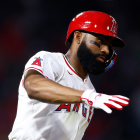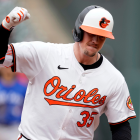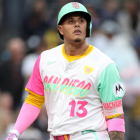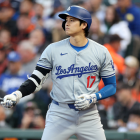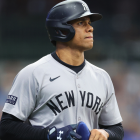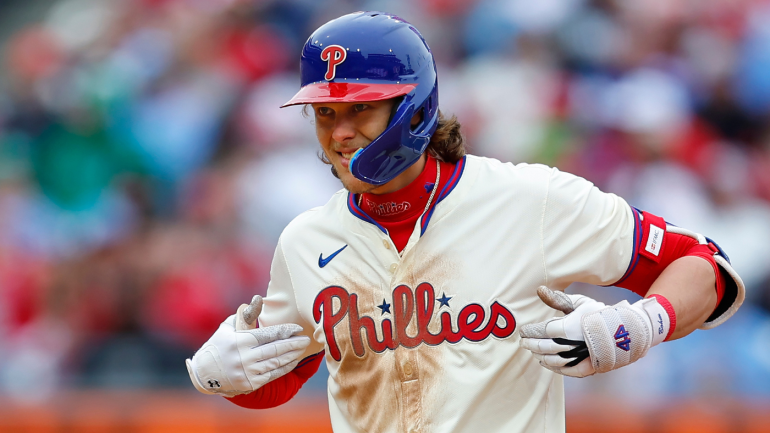
The 2024 MLB season is now more than a month old and we can't say "it's still early" much longer. Fewer things around the league are blips or small sample size noise. A lot of what we've seen these last few weeks is beginning to become real, both good and bad. With that in mind, here are a few trends worth knowing now that we're in May.
Bohm's breakout
At 20-11, the Phillies are off to their best start since the 2011 team started 21-10, and they've done it with superlative starting pitching. Philadelphia's starters have a 2.47 ERA and they're averaging an MLB best 5.97 innings per start. Just about every night the Phillies get a quality outing that puts them in position to win.
Another reason the Phillies have started so well: Alec Bohm. Now in his fourth full MLB season, Bohm is slashing .366/.438/.598 with the lowest strikeout rate (14.8%), highest walk rate (11.7%), and lowest swinging strike rate (5.4%) of his career. From 2021-23, Bohm was an average at best hitter, and below average for a corner infielder. This year he's one of the top hitters in the league.
Bohm, 27, is entering his prime, and he was the No. 3 pick in the 2018 draft, so he's always had pedigree. And really, even during his underwhelming 2021-23 seasons, he paired strong contact rates with good exit velocities. There were reasons to believe he had more to give offensively. Bohm had approach issues more than bat-to-ball issues.
This season Bohm has been far more selective, cutting his chase rate from 30.4% from 2022-23 to 20.4% in 2024. The MLB average is 27.7%. It's not just about chasing fewer pitches outside the strike zone though. Bohm has also done a much better job being more selective within the strike zone. Here are his swing heat maps:
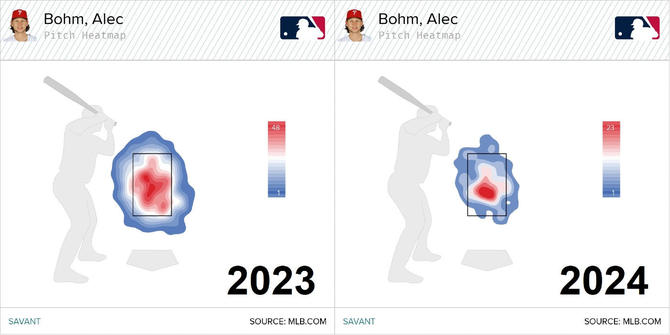
There is more to being a disciplined hitter than not swinging at balls. Oftentimes the difference between a good hitter and a great hitter is knowing which pitches are hittable, and which pitches you should take, even if they're in the zone and a strike. Bohm's made that leap this year. He's no longer swinging at pitches the opposing pitcher wants him to swing at.
"My whole life I have been really good at putting the bat on the ball," Bohm told the Philadelphia Inquirer recently. "And there's time where it gets me in trouble. Where I'll swing at a pitch that's on the corner and hard to hit, but I'll touch it. And I end up fouling it off or putting it in play and get out. So it's just trying to shrink the plate a little bit."
This league is unforgiving and it won't be long before opposing teams adjust to Bohm's more disciplined approach, and he'll have to adjust back. There are reasons to believe his great start is more than just a season-opening hot streak though. Bohm has always been a good bat-to-ball guy and now he's much more selective within the zone. He's more dangerous than ever.
Hicks thriving as a starter
The Giants raised a few eyebrows over the winter when they signed longtime reliever Jordan Hicks with the intention of putting him in the rotation. The Cardinals gave Hicks a chance to start in 2022 and it didn't go well (5.47 ERA in eight starts), plus relievers with an injury history and high walk rates typically don't make good starters. And yet, the Giants were ready to try it.
"We're thinking of Jordan very much as a conventional starter," Giants POBO Farhan Zaidi said at Hicks' press conference. "We want him to be in a situation to start games, to have a full starter's workload, even though it might be a little conservative. Jordan, from a natural talent standpoint, he can do some things with a baseball that very few guys in baseball can do."
One month into 2024, the Hicks as a starter experiment is going better than I think even Zaidi and the Giants would admit. He owns a 1.59 ERA through six starts, has completed at least five innings each time out despite averaging only 87 pitches per start, and his walk rate is a career low 7.7%. Statcast puts his expected ERA at 2.50 based on the quality of contact he's allowed.
"I just really wanted to come out here with a lot of confidence in my pitches," Hicks said after striking out a career-high nine in his last start (via MLB.com). "I know I have pretty good stuff and I think if I was to be in the zone more with it, these kinds of things might happen. I really like where I'm at."
Known for his 100 mph sinker as a reliever, Hicks is averaging "only" 96.4 mph with the pitch this year. A dip in velocity is expected with a move into the rotation, though there's also reason to believe it's at least somewhat intentional. Hicks has thrown 66% of his sinkers in the zone this year, up from 55% in years past. He's taking a little off and landing the sinker in the zone more often.
That helps explain the career-best walk rate and also the career-low 20.8% strikeout rate. The sinker is in the zone more often and easier to get the bat on. But, because it's so heavy and still has so much velocity, hitters are putting the ball the ground nearly 60% of the time against Hicks, with poor exit velocity to boot. He's very difficult to square up. Now he's walking fewer hitters too.
Hicks threw 61 1/3 innings in 2022 and 65 2/3 innings in 2023, and he's already up to 34 innings in 2024. At some point the Giants will have to cut back on his workload. That's something to worry about another time though. Right now Hicks, who is still only 27, is showing signs of being an effective starter. That four-year, $44 million contract looks like a bargain for San Francisco.
The decline in reliever strikeouts
Never before has baseball been so bullpen-centric. Starters are throwing fewer and fewer innings with each passing season and relievers have to pick up the slack. Teams are averaging 4.24 pitchers per game in 2024. Go back 10 years to 2014, and it was 3.98 pitchers per game. It's one extra pitcher every four games, give or take. That's per team. It's a lot. It really is.
Generally speaking, teams want strikeouts in the late innings because nothing bad can happen when the opposing team doesn't put the ball in play. It is no surprise then that reliever strikeout rates have been higher than starter strikeouts rate for years and years. Lately though, reliever strikeout rates are trending down. Here are the last few years:
| SP K% | SP K/9 | RP K% | RP K/9 | |
|---|---|---|---|---|
2021 | 22.6% | 8.62 | 24.0% | 9.27 |
2022 | 21.6% | 8.18 | 23.6% | 9.02 |
2023 | 22.1% | 8.47 | 23.6% | 9.12 |
2024 | 22.3% | 8.48 | 22.8% | 8.74 |
Starter strikeout rates have more or less held steady these last four years. The difference between 2021 and 2024 is tiny. Relievers, though, have seen their strikeout rates decline significantly. We're talking more than a full percentage point in terms of batters faced from 2021 to 2024, and more than half a strikeout per nine innings pitched. Bullpens are missing fewer bats these days.
Why is this happening? There are many reasons. The pitch clock, for example, limits max effort pitching. No longer can a reliever throw a pitch as hard as he can, take 30 seconds to recover, throw another pitch as hard as he can, rinse and repeat. This applies to starters too, though they don't employ the max effort pitching style as much as relievers. Relievers really go all out.
Also, several teams -- smart teams like the Astros, Phillies, Yankees, etc. -- are prioritizing contact management. They want pitchers who can miss bats, for sure, but they also want pitchers who can suppress hard contact. Even the highest strikeout pitchers allow a lot of balls in play, and teams are doing what they can to make sure those balls in play don't leave the park or go for extra bases, even at the cost of strikeouts.
And let's not forget about all the attrition. Every day we hear about a pitcher or three getting hurt, and someone has to replace those innings. Teams are having to dip deeper into their depth and there is not an endless supply of major-league caliber pitchers. Injuries have diluted the talent pool to a certain extent. Fewer bat-missing relievers are available as pitchers get hurt.
There's also the three-batter minimum (which is not that new), the foreign substance ban, the universal DH, and a host of other factors that have cut into the league strikeout rate, especially among relievers. And this is not a bad thing! More balls in play is good for baseball overall. For the first time in a while, strikeouts have become harder to come by among bullpeners.





















